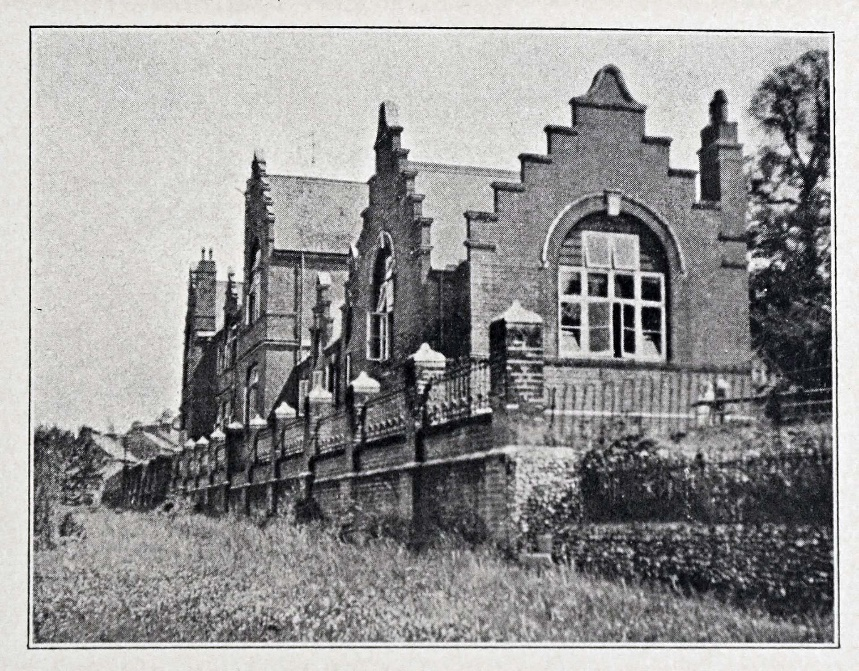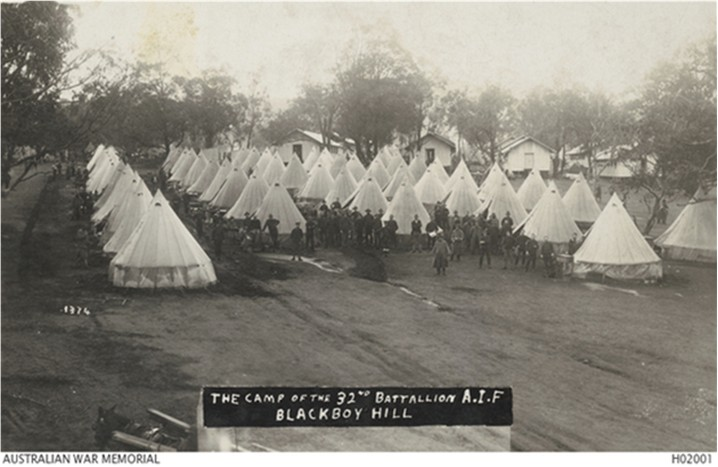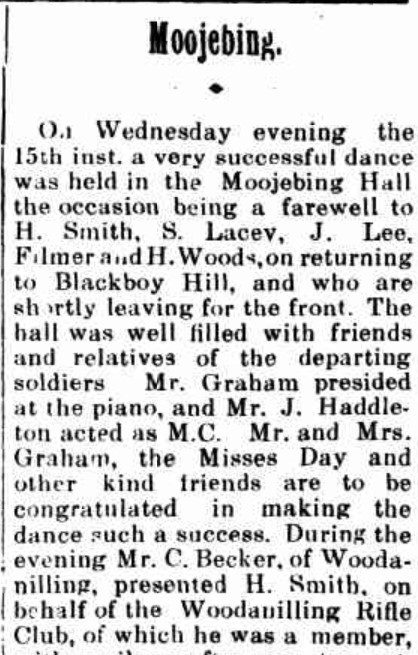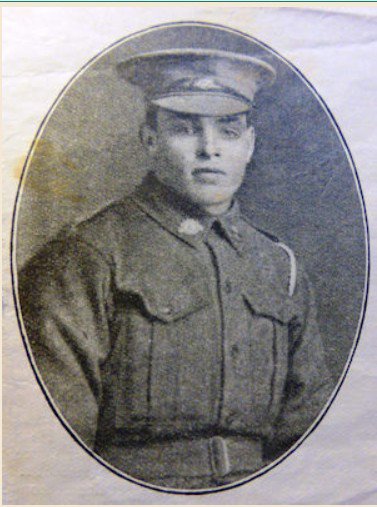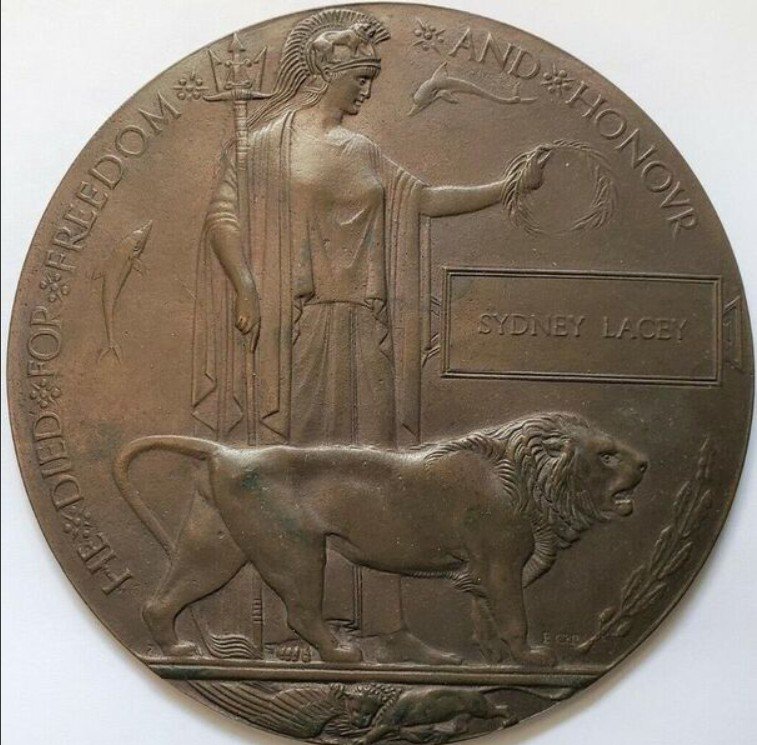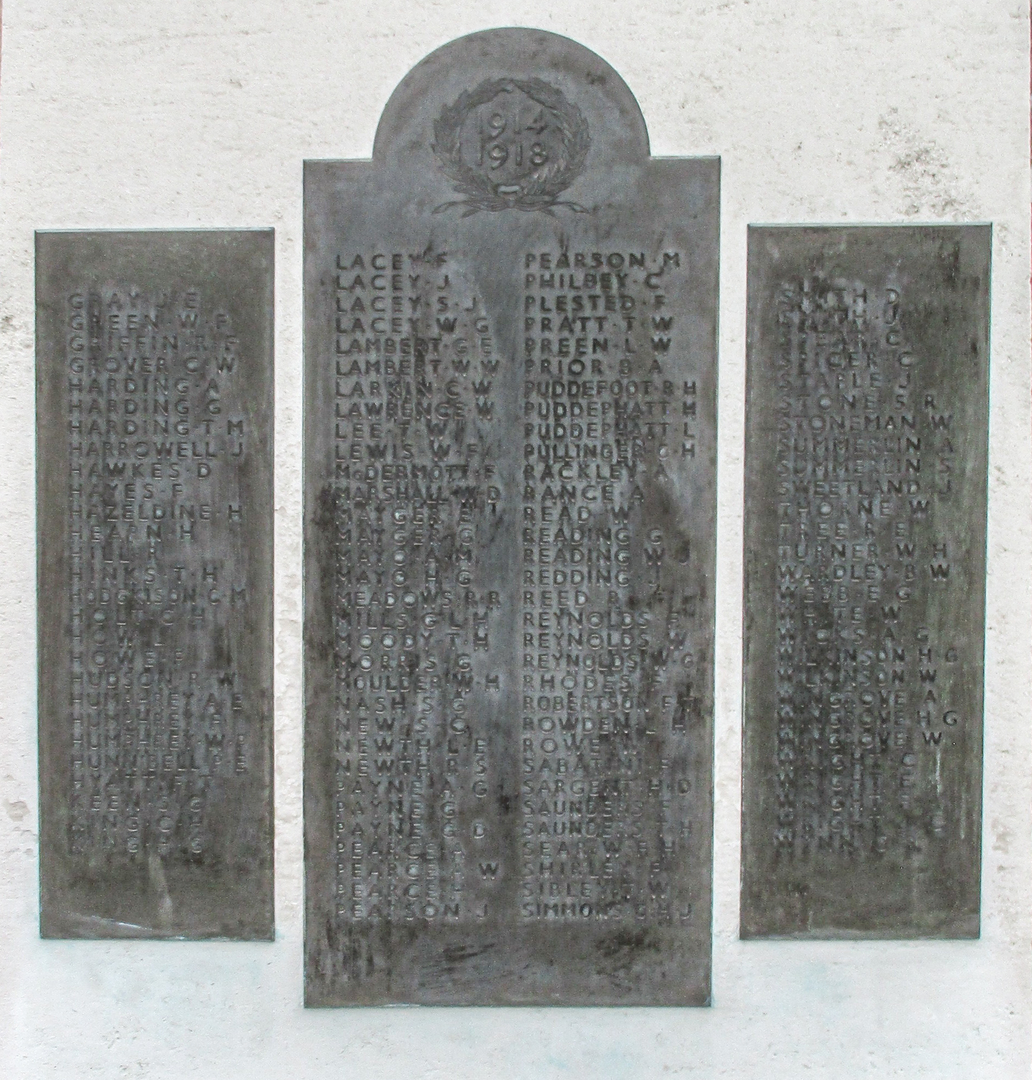Sydney James LACEY
Eyes blue, Hair brown, Complexion fair
Sydney Lacey and James Lee – Friends Killed in Action
Can you help us identify Sydney?
Sydney James Lacey’s body was never found after the Battle of Fromelles, and there are no records of his burial.
A mass grave was found in 2008 at Fromelles, a grave the Germans dug for 250 Australian soldiers they recovered after the battle. As of 2024, 180 of these soldiers have been able to be identified via DNA testing.
Sydney may be among these remaining unidentified men. There is still a chance to identify him — but we need help. We welcome all branches of his family to come forward to donate DNA to help with his identification, especially those with roots in Chesham, Buckinghamshire, England.
See the DNA box at the end of the story for what we do know about his family.
If you know anything of contacts for Walter, please contact the Fromelles Association.
Early Life
Sydney James Lacey, known as “Sid” to his friends, was born on 2 January 1893 at 22 Gladstone Road in Chesham, Buckinghamshire, England. He was the third son of Harry Lacey, a widower, and Laura Bates, a widow, who had married in 1887. Together, Harry and Laura raised a large, blended family that included children from both of their earlier marriages as well as five children of their own.
Sid’s half-siblings from his father’s first marriage to Elizabeth Ann Wilson were:
- Harry (1872-1959),
- Sophia (1874-1923),
- Louisa (1876-1967),
- William (1882 - 1959)
- and George William (1883-1916), who was Killed in Action in France.
His full siblings were:
- Clement William (1887 - ),
- Frank (1890-1894),
- Florence Winifred “Winnie” (1894-1960)
- and Harold (1898 - ).
Sid attended White Hill School in Chesham and later worked as a farmhand for a Mr. Marshall, a local farmer in the Chesham area.
At 19, Sid emigrated to Australia in June 1912 aboard the SS Australind, arriving at Fremantle, Western Australia. Like many young English migrants of the time, he was drawn by the promise of agricultural work and opportunity. He settled in Katanning, 280 km southeast of Perth, in the state’s Great Southern region. He worked on local farms and became close friends with other young British migrants in the area. This rural life in Western Australia was not destined to last. As the war in Europe escalated, Sid and several mates from Katanning felt the call to enlist, joining thousands of others across Australia who volunteered for the Australian Imperial Force.
Off to War
Sid enlisted on 12 July 1915 at Blackboy Hill, WA with his friends James “Jim” Thomas Lee (982) and Horace Bernard Smith (1053) also from Kattanning. They were assigned to the newly formed 32nd Battalion, C Company. Thomas Parkins (1027), another friend, signed up a couple of days later. Like Sid, Thomas was originally from Buckinghamshire, England.
The 32nd Battalion was formed at Mitcham, South Australia. A and B Companies were made up of recruits from South Australia and C and D Companies came from Western Australia. The WA men did their initial training at the Blackboy Hill camp before heading to South Australia to complete the Battalion.
In late August, Sid and his mates departed WA to join those who had been training in Adelaide, where further training would be done at the Cheltenham Racecourse Camp. Sid and his mates were given a good sendoff at Moojebing.
The full battalion departed from Adelaide for Egypt on 18 November 1915, with the unit being split between two troop ships HMAT A2 Geelong and HMAT A13 Katuna. Sid was on the Geelong . They arrived in Suez on 18 December. As reported in The Adelaide Register:
“The 32nd Battalion went away with the determination to uphold the newborn prestige of Australian troops, and they were accorded a farewell which reflected the assurance of South Australians that that resolve would be realized.”
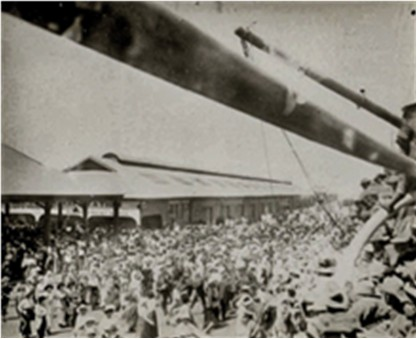
The 32nd arrived in Suez and moved to El Ferdan just before Christmas. A month later they marched to Ismailia and then to the major camp at Tel-el-Kebir where they stayed for February and most of March. Tel-el-Kebir was about 110 km northeast of Cairo and the 40,000 men in the camp were comprised of Gallipoli veterans and the thousands of reinforcements arriving regularly from Australia. Their next stop was at Duntroon Plateau and then at Ferry Post until the end of May where they trained and guarded the Suez Canal.
Their last posting in Egypt was a few weeks at Moascar. One soldier’s diary complained of being “sick up to the neck of heat and flies”, of the scarcity of water during their long marches through the sand and he described some of the food as “dog biscuits and bully beef”. He did go on to mention good times as well with swims, mail from home, visiting the local sights and the like.
Source AWM C2081789 Diary of Theodor Milton PFLAUM 1915-16, page 29, page 12
Sid and his mates clearly enjoyed the swims in the Canal!

L to R: Pte William Heath 950, Wounded in Action, Lieut Horace B Smith 1053, Pte James Thomas Lee 982, KIA Fromelles, Thomas Parkins 1027, Wounded in Action, and Robert Grieve Moncreiff Scott 1046, KIA 20/7/1916, who was identified at Pheasant Wood.
During their time in Egypt the 32nd did have the honour of being inspected by H.R.H. Prince of Wales.
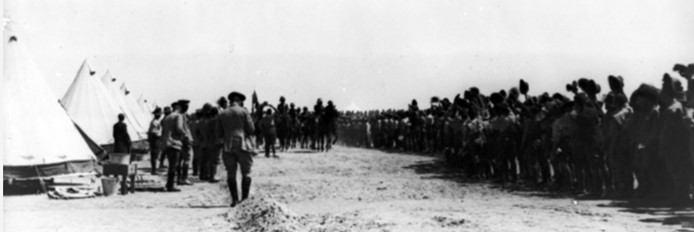
After spending six months in Egypt, the call to support the British Expeditionary Force on the Western Front came in mid-June. The 32nd left from Alexandria on the ship Transylvania on 17 June 1916, arriving at Marseilles, France on 23 June 1916 and they then immediately entrained for a three-day train trip to Steenbecque. Their route took them to a station just out of Paris, within sight of the Eiffel Tower, through Boulogne and Calais, with a view of the English Channel, before disembarking and marching to their camp at Morbecque, about 30 kilometres from Fleurbaix.
Theodor Pflaum (No. 327) and Wesley Choat (No. 68) wrote about the trip:
“The people flocked out all along the line and cheered us as though we had the Kaiser as prisoner on board!!” – Theodore Pflaum
“The change of scenery in La Belle France was like healing ointment to our sunbaked faces and dust filled eyes. It seemed a veritable paradise, and it was hard to realise that in this land of seeming peace and picturesque beauty, one of the most fearful wars of all time was raging in the ruthless and devastating manner of "Hun" frightfulness”. – Wesley Choat
They were headed to the area of Fleurbaix in northern France which was known as the ‘Nursery Sector’ – a supposedly relatively quiet area where inexperienced Allied troops could learn the harsh realities of Western Front trench warfare against the Germans. But the quiet times did not last long. Training continued with a focus on bayonets and the use of gas masks, assuredly with a greater emphasis, given their position near the front. The 32nd moved to the Front on 14 July and Sid and his mates were into the trenches for the first time on 16 July, only three weeks after arriving in France.
Battle of Fromelles
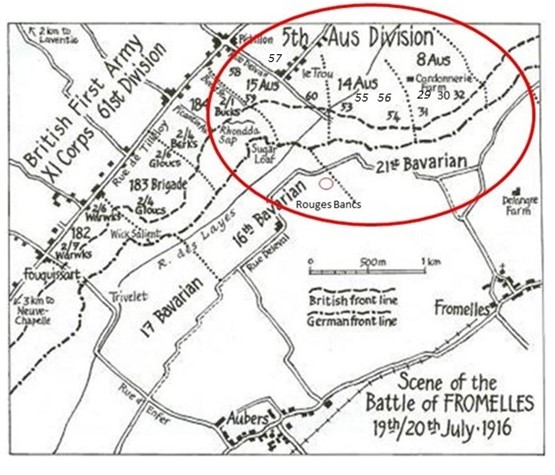
On the 17th they were reconnoitring the trenches and cutting passages through the barbed wire, preparing for an attack, but it was delayed due to the weather. D Company’s Lieutenant Sam Mills’ letters home were optimistic for the coming battle:
“We are not doing much work now, just enough to keep us fit—mostly route marching and helmet drill. We have our gas helmets and steel helmets, so we are prepared for anything. They are both very good, so a man is pretty safe.”
The overall plan was to use brigades from the Australian Fifth Division to conduct a diversionary assault on the German trenches at Fromelles. The 32nd Battalion’s position was on the extreme left flank, with only 100 metres of No Man’s Land to get the German trenches. As they advanced, they were to link up with the 31st Battalion on their right. However, their position made the job more difficult, as not only did they have to protect themselves while advancing, but they also had to block off the Germans on their left, to stop them from coming around behind them. On the morning of the 18th, A Company and Sid’s C Company went into the trenches to relieve B and D Companies, who rejoined the next day.
The Zero Hour for advancing from their front-line trenches was to be 5.45 PM, but the Germans knew this attack was coming and were well-prepared. They opened a massive artillery bombardment on the Australians at 5.15 PM, causing chaos and many casualties. The charge over the parapet began at 5.53 PM. Sid’s C Company and A Company were in the first and second waves to go, B & D were in the third and fourth.
They were successful in the initial assaults and by 6.30 PM were in control of the German’s 1st line system (map Trench B), which was described as “practically a ditch with from 1 to 2 feet of mud and slush at the bottom”.
Source: AWM4 23/49/12, 32nd Battalion War Diaries, July 1916, page 11
Unfortunately, with the success of their attack, ‘friendly’ artillery fire caused a large number of casualties because the artillery observers were unable to confirm the position of the Australian gains. They were able to take out a German machine gun in their early advances, but were being “seriously enfiladed” from their left flank.
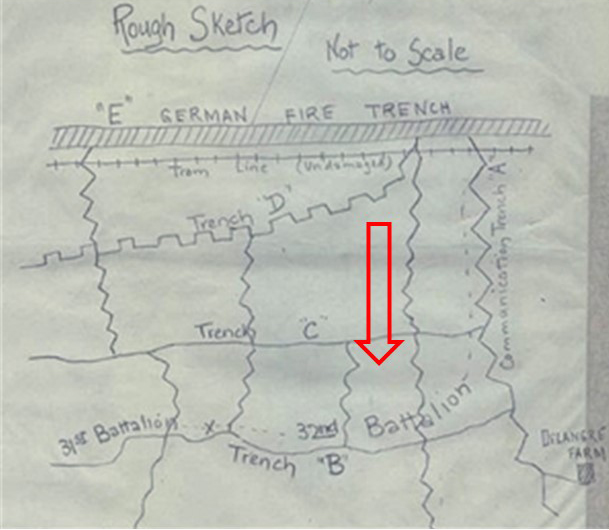
By 8.30 PM their left flank had come under heavy bombardment with high explosives and shrapnel. Return bombardment support was provided and the 32nd were told that “the trenches were to be held at all costs”.
Source: AWM4 23/49/12, 32nd Battalion War Diaries, July 1916, page 12
Fighting continued through the night. The Australians made a further charge at the main German line beyond Trench B, but they were low on grenades, there was machine gun fire from behind them from the emplacement at Delangre Farm and they were so far advanced that they were getting shelled by both sides. In the early morning of the 20th, the Germans began a counterattack from the Australian’s left flank, bombing and advancing into Trench A (map).
Given the Australian advances that had been made earlier, the rear Trench E had been left almost empty, which then enabled the Germans to regain that trench and envelop the men of the 32nd. At 5.30 AM the Germans attacked from both flanks in force and with bombing parties. Having only a few grenades left, the only resistance they could offer was with rifles:
“The enemy swarmed in and the retirement across No Mans’ Land resembled shambles, the enemy artillery and machine guns doing deadly damage.”
What was left of the 32nd had finally withdrawn by 7.30 AM on the 20th. The initial roll call count was devastating – 71 killed, 375 wounded and 219 missing, including Sid and Jim. To get some perspective of the battle, when Charles Bean, Australia’s official war historian, attended the battlefield two and half years later, he observed a large quantity of bones, torn uniforms and Australian kit still on the battlefield. The final impact was that 228 soldiers of the 32nd Battalion were killed or died from wounds sustained at the battle and, of this, 166 were unidentified.
Lieutenant Sam Mills survived the battle. In his letters home, he recalls the bravery of the men:
“They came over the parapet like racehorses……… However, a man could ask nothing better, if he had to go, than to go in a charge like that, and they certainly did their job like heroes."
After the Battle
Sid was reported as killed in action on 19 July 1916 at Fromelles, along with his close friend James Lee. No records exist of Sid being seen during or after the battle and there are no eyewitness reports that suggest he was wounded or taken prisoner. His name did not appear on any German death lists and his body was never recovered.
News of his death made it back to England quickly - the following article was in the 11 August 1916 edition of the Buckinghamshire Examiner, in which the Chaplin said - “the boys fought with wonderful bravery and Australia is indeed proud of them. They sacrificed their lives in a righteous cause, and it will never be forgotten.”
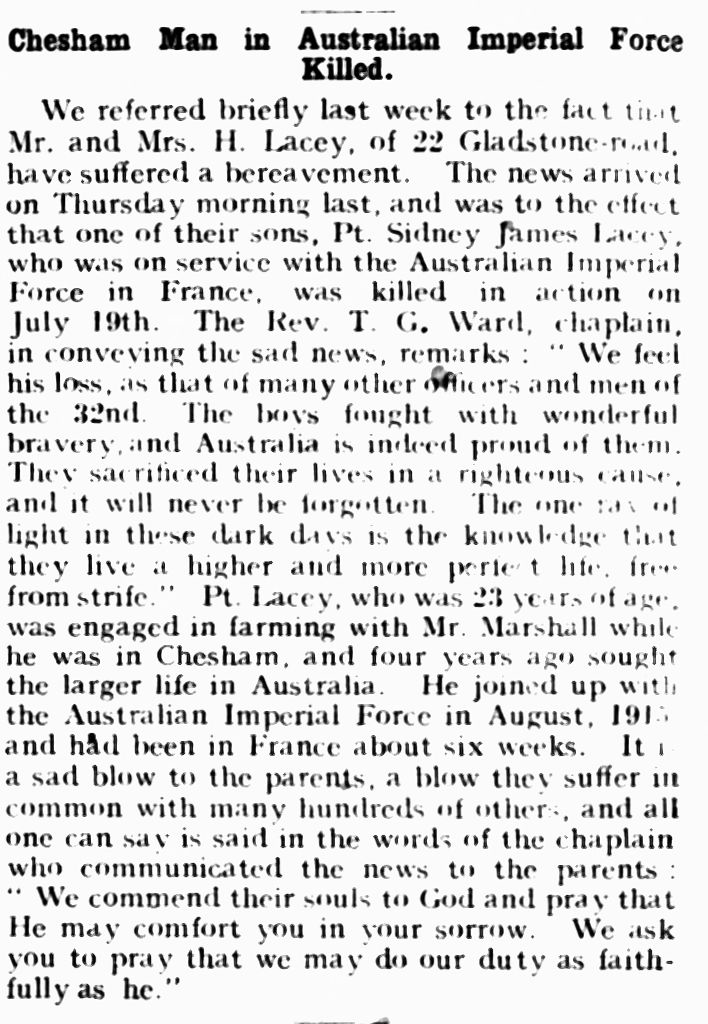
For the Lacey family, Sid’s loss was not the only one from the war. Only three months later, on 12 October 1916, Sid’s brother George William “Wilson” Lacey was also killed in action on the Western Front. The family placed several heartfelt memorial notices in local newspapers over the following years, grieving the loss of two sons in such a short time. Their brother Clement was offered an exemption from service due to the devastating impact of these losses.
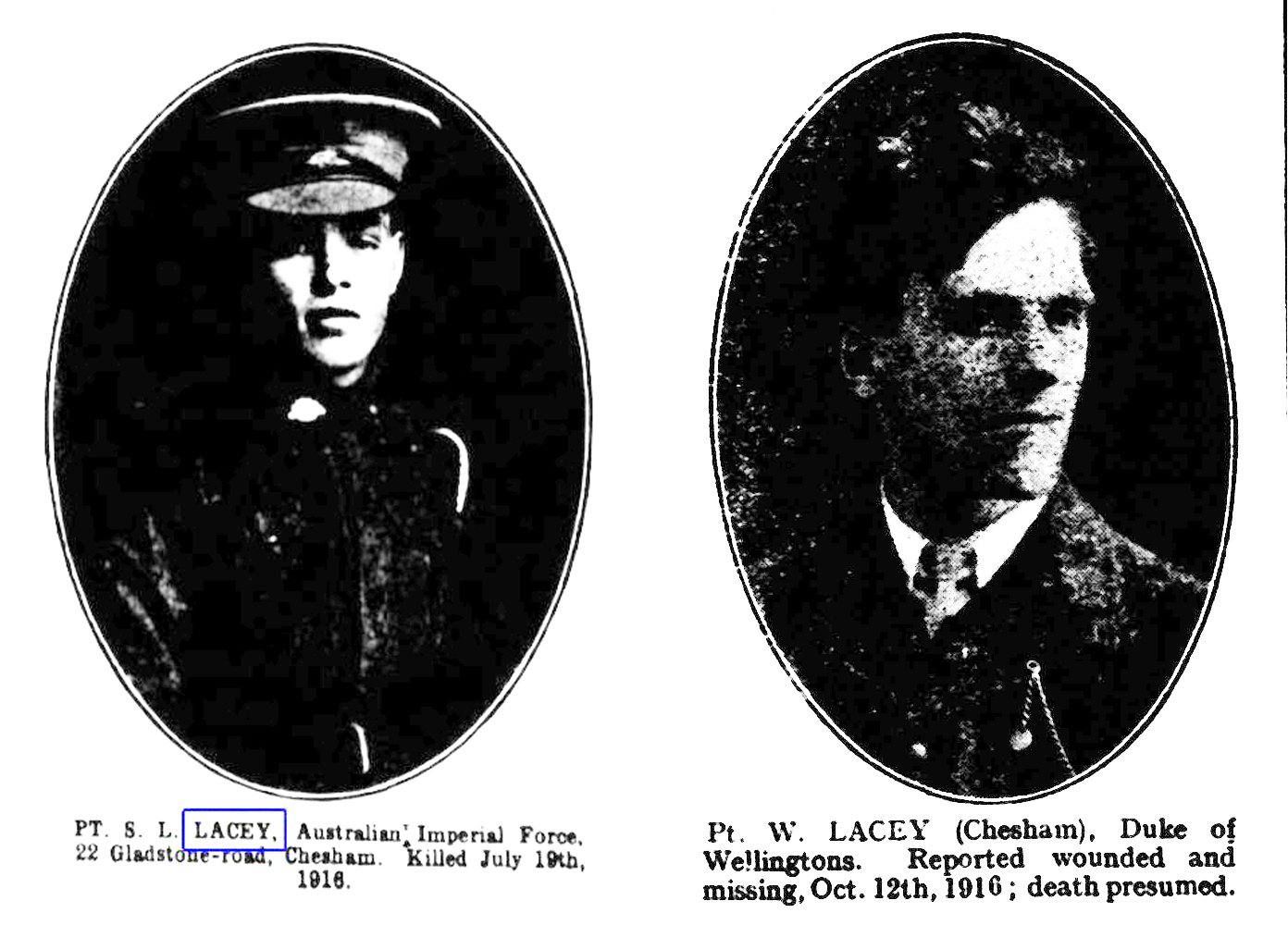
His new found Australian friends fared little better, Sid’s mate Jim Lee was also killed during the battle and Thomas Parkins was wounded and was sent to Australia in September 1916. Another friend, Horace Bernard Smith, survived. Horace rose to the rank of lieutenant and was awarded the Military Cross for his actions at Fontaine-les-Cappy in August 1918. Sid and Jim’s close ties are reflected in Jim’s sister’s tribute on 22 September 1916.
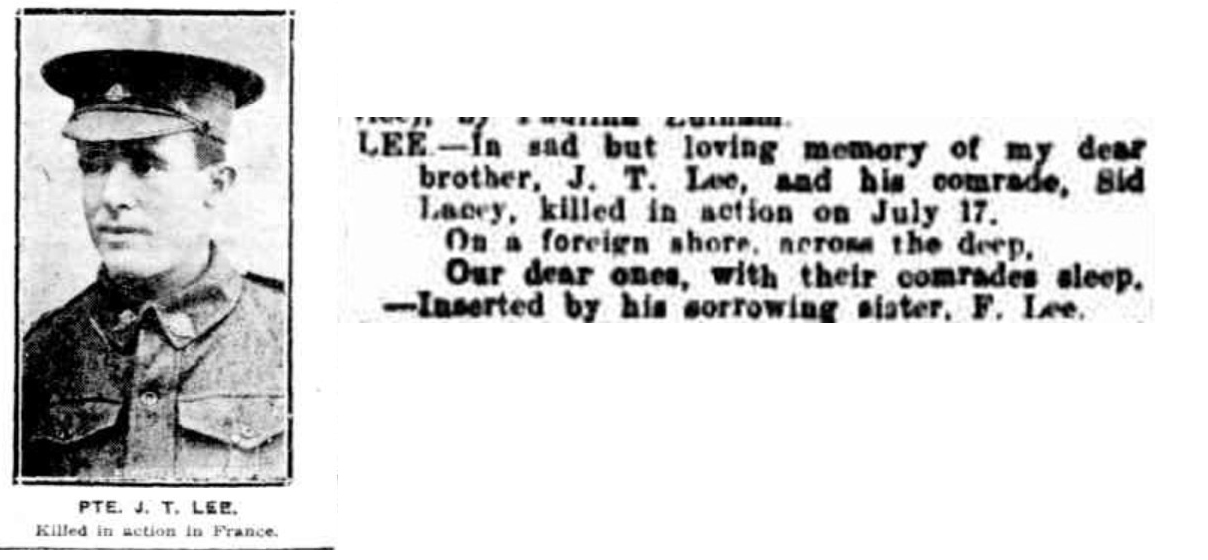
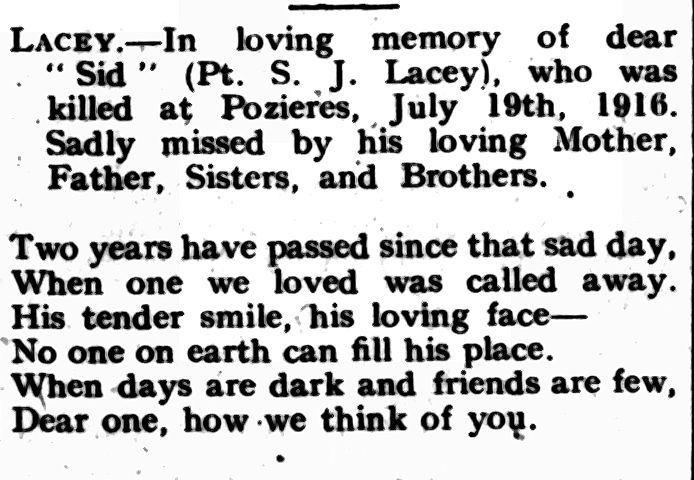
In 1919, Sid’s sister placed a memorial notice in the Western Mail. Her words are a poignant reminder of the grief felt by families left behind:
“In loving memory of our dear brothers, Privates Sid and George Lacey, killed in action in France. Too dearly loved to be forgotten.”
Though his body was never recovered, Sid’s legacy lives on — in the quiet villages of Western Australia where he once worked, in the town of Chesham that raised him, and on the fields of France where he gave his life alongside his mates.
Sid is commemorated at :
- Australian War Memorial Roll of Honour
- VC Corner
- Chesham War Memorial
Finding Sid
After the battle, the Germans recovered 250 Australian soldiers and placed them in a burial pit at Pheasant Wood. This grave was discovered in 2008 and since then efforts have been underway to identify these soldiers by DNA testing from family members.
As of 2025, 180 of the soldiers have been identified, including 41 of the 166 unidentified soldiers from the 32nd Battalion. We welcome all branches of Sid’s family to come forward to donate DNA to help with his identification. If you know anything of family contacts, please contact the Fromelles Association. We hope that one day Sid will be named and honoured with a known grave.
Please visit Fromelles.info to follow the ongoing identification project and Sid’s story.
DNA samples are being sought for family connections to
| Soldier | Sydney James LACEY (1893–1916) |
| Parents | Harry Lacey (1852–1927) and Laura Bates (1858–1919) and 1st Marriage Elizabeth Ann Wilson |
| Siblings | Clement William Lacey (1887–1958) m. Annie Preston (1894– ) | ||
| Frank Lacey (1890–1894) | |||
| Florence Winifred “Winnie” Lacey (1894–1960) m. Joseph Kempster (1893– ) | |||
| Harold Lacey (1898–?) m. Norah Moon (1904– ) |
| Half Siblings | Harry Lacey (1872–1959) m. Rhoda Puddephatt (1874–1958) | ||
| Sophia Lacey (1874–1923) | |||
| Louisa Lacey (1876–1967) m. Charles Wheeler | |||
| William Lacey (1877–1959) m. Florence Blake | |||
| George William “Wilson” Lacey (1884–1916) m. Grace Palmley Scott |
| Grandparents | ||||
| Paternal | Thomas Lacey (1815–?) and Sophia Atkins (1814–1868) | |||
| Maternal | Joseph Bates (1829–1884) and Elizabeth Harkness (1829–1898) |
Seeking DNA Donors

Contacts
(Contact: carla@fromelles.info or geoffrey@fromelles.info).
(Contact: army.uwc@defence.gov.au or phone 1800 019 090).
Donations
If you are able, please contribute to the upkeep of this resource.
(Contact: bill@fromelles.info ).

